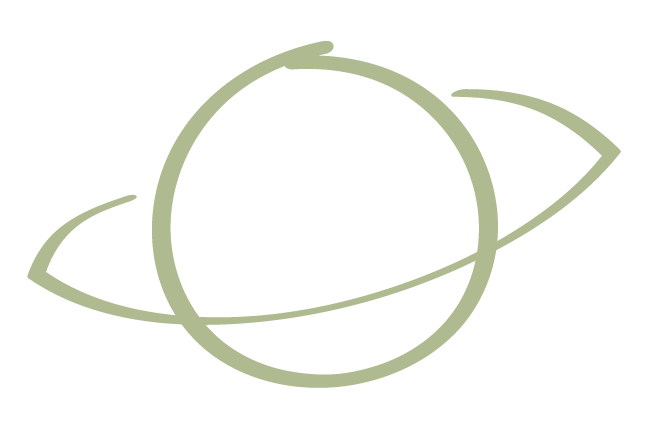How to Actually Learn Astrology
It can be super overwhelming to know where to start when learning astrology. There are so different resources available and so many different opinions on the “right” place to start.
While there is no one “right” place to start learning astrology, this simple, straight-forward guide to learning astrology from the ground up—created by the astrologer behind saturn and honey—offers a grounded foundation to build from.
If you’re looking for a professional birth chart reading, head over to my readings section to book your virtual one-on-one session from anywhere in the world.
1. Get to know the planets in astrology
The first step to learning astrology is getting to know the planets – their myths, their meanings in astrology, etc. – and their symbols.
There are 10 ‘planets’ (including the sun and moon) in astrology. Many astrologers include other calculated points, asteroids, and more in their interpretations. Start with the 10 planets and their meanings and symbols.
Astrological symbols for the planets:
The symbol for the sun in astrology: ☉
The symbol for the moon in astrology: ☽
The symbol for Mercury in astrology: ☿
The symbol for Venus in astrology: ♀
The symbol for Mars in astrology: ♂
The symbol for Jupiter in astrology: ♃
The symbol for Saturn in astrology: ♄
The symbol for Uranus in astrology: ♅ or ⛢
The symbol for Neptune in astrology: ♆
The symbol for Pluto in astrology: ♇ or ⯓
2. Get to know essential dignity in astrology
The planets are essentially what give the signs their meanings. Familiarizing ourselves with planetary dignity gives us a really strong foundational understanding of the signs and why they mean what they mean.
Essential dignity describes a planet’s “condition.” It describes how easily, predictably, directly and traditionally a planet expresses itself. It’s the idea that some planets are more naturally in alignment with certain signs. Understanding essential dignity is core to a stable foundation in astrology, as the signs get their meaning in part from these dignities. Essential dignity explains why a sign is the way that it is.
What are essential dignities in astrology?
Domicile in astrology is the sign/s a planet rules. Planets in domicile show up in the exact way you’d expect them to.
Exaltation in astrology is the sign in which a planet performs effortlessly and in the ways that we expect it to. When a planet is exalted, it’s as if the sign is elevating its function.
Detriment or exile in astrology is the sign/s in which a planet struggles and where it has to find different, more unconventional ways to express itself.
Fall in astrology is the sign that a planet tends to struggle in, but holds great wisdom about.
Learn more about dignity in full article I wrote on essential dignity.
3. Learn about the elements in astrology
The elements, or triplicities, in astrology are fire, earth, air, and water. There are 3 signs of each element (or triplicity).
The fire signs in astrology are: Aries, Leo, Sagittarius
The earth signs in astrology are: Taurus, Virgo, Capricorn
The air signs in astrology are: Gemini, Libra, Aquarius
The water signs in astrology are: Cancer, Scorpio, Pisces
4. Learn about the modalities in astrology
In astrology, the modalities, or quadruplicities, in astrology are cardinal, fixed, and mutable. There are four signs of each modality.
The Cardinal signs in astrology are: Aries, Cancer, Libra, and Capricorn. These signs come at the beginning of a season and are therefore associated with initiation and beginning.
The Fixed signs in astrology are: Taurus, Leo, Scorpio, and Aquarius. These signs come in the middle of a season and are therefore associated with sustaining, steadiness, and strengthening.
The Mutable signs in astrology are: Gemini, Virgo, Sagittarius, and Pisces. These signs come at the end of a season and are therefore associated with change, endings and the turning of the wheel.
5. Add in the 12 houses and their meanings in astrology
Once you feel comfy with those topics, add in the 12 houses and their meanings.
The 12 houses in astrology and their basic meanings
Your birth chart is not just a chart. It’s a "map" of the sky at the exact moment you were born, in exact location you were born. (This is why astrologers need your exact birth time and place!)
As we can see above, the birth chart is a circle. The houses are labeled on the inside and go counterclockwise. The ascendant (or rising sign) is always the same as the first house, and represents the eastern horizon. The ascendant is the sign that was literally rising on the eastern horizon at the moment you were born. The descendant is always in the 7th house, and it represents the western horizon. The descendant sign is the sign that was literally descending, or setting, on the western horizon at the moment you were born.
The top half of an astrological chart is made up of houses 7 through 12. Any planets or signs within these houses were visible in the actual sky at the moment you were born. The sign/planets in the 10th house, for example, were right above head when you were born, visible and in plain view.
The bottom half of the chart is made up of houses 1 through 6. Any planets or signs within these houses were not visible when and where you were born; planets/signs within these houses were only visible on the other side of the earth at the moment you were born. If you were born at night, the sun will always be in houses 1 through 6. If you were born at midnight, for example, your sun will most often be in the 4th house, sitting at the very bottom of the chart.
When learning about the houses in astrology, I recommend using the whole sign house system. There are many other house systems (some examples: Placidus, Porphyry, Equal, Koch, Campanus, etc.) and there is truth in all house systems, but whole sign is the easiest to read when starting out, and in my experience, it is also the most startlingly accurate.
6. Add in planetary aspects
Once you're comfortable with houses, you can add in aspects.
'Aspects' are the geometric angles that planets make to one another and they add an extra level of nuance to the chart. Angles describe how the planets influence or ‘speak to’ one another.
The major aspects in astrology are conjunctions, squares, oppositions, trines, and sextiles. There are other minor aspects, but those are not important to know right now. Many astrologers don’t use minor aspects at all.
In astrology, conjunctions occur when planets are right next to one another.
In astrology, squares occur when planets are about 90º from one another.
In astrology, oppositions occur when planets are about 180º from one another.
In astrology, trines occur when planets are 120º from one another.
In astrology, sextiles occur when planets are 60º from one another.
However, the planets do not have to be exactly these number of degrees from each other. I generally use a 9º orb. This means, for example, that if two planets are anywhere from 81º-99º from one another, they are square each other. But if they are exactly 90º from one another, they are making an exact square.
Below is an example of what aspects look like in a birth chart. The lines crisscrossing in the center of the chart are the aspects. Conjunctions, squares, and oppositions are typically displayed in red, indicating the more ‘intense’ vibe of these aspects. Trines and sextiles are typically displayed in blue, suggesting their smoother, less intense nature.
Angelina Jolie’s birth chart
And those are the basics of what you need to know in order to get started on reading your own chart!
Recommended astrology resources:
*I am in no way affiliated with any of the people or products mentioned below. These are my genuine suggestions.
Birth chart calculators:
• Astrodienst — Requires a signup, and once signed up you’re able to save up to 100 charts for free. Tons of different options, easy-to-read chart graphics, has almost everything you’d need. One note: if you pull a chart that has a very late degree or very early degree ascendant (like, 0º00’ or 29º59’), try putting it into one of the other sites or apps too. In cases like these, astro.com will sometimes show a different rising sign than all the others.
Astrodienst also offers online ephemerides. An ephemeris is a chart of planetary movements through time; when we want to find out when a planet changes aigns or hits a certain degree, an ephemeris is where to look. Astrodienst has 9000 years of ephemerides available for use.
They also have a databank of celebrity birth charts, which is truly an invaluable resource for research.
• Astro-Seek - No sign-up required, tons of different options to play around with!
• Alabe.com — Display options are limited (for instance, they only show the chart in the Placidus house system), but this is a good, reliable place to quickly look up a chart.
• Cafeastrology.com – The quintessential beginners’ website.
• TimePassages – A great, reliable app. Free with options to pay for add-ons.
• AstroGold software & app – This is the astrology software that I use as a professional astrologer. Available for macOS, iOS, and Android. If you’re not a professional astrologer, you probably don’t need to purchase this software.
• CHANI app – Currently available only for iOS; Android-friendly version will be released August 2023. Free and paid options.
Books / courses:
• The very first astrology book I ever owned was The Only Astrology Book You'll Ever Need by Joanna Martine Woolfolk. While it’s definitely not actually the only astrology book you'll ever need, it felt very accessible to me when I was just starting out.
• A lot of people love You Were Born For This: Astrology for Radical Self-Acceptance by Chani Nicholas. I haven't read this one in full, but I feel confident recommending it.
• Hellenistic Astrology: The Study of Fate and Fortune by Chris Brennan is a denser book with a traditional perspective on astrology. I'm not a traditional or Hellenistic astrologer, but this is a quality book for understanding the foundations. He also has a great free podcast called The Astrology Podcast.
• Astrology for the Soul by Jan Spiller has tons of good info on the north node and south node.
• Planets in Transit by Robert Hand is a must-have for understanding transits.
• Austin Coppock’s course on the lunar nodes is fantastic.
• Postcolonial Astrology by Alice Sparkly Kat is well-loved. (They also have a lot of great free info on their website.)
Other online resources:
There are too many free websites and podcasts to even begin to list, but an exhaustive list will be added here in the future! For the time being, explore the article section here on saturnandhoney.com. The Your Chart section is the one to look at for information on reading a birth chart. More articles are added regularly.
Communities on Twitter, Facebook, and Instagram are all free resources where you absolutely have to use plenty of discernment and critical thought, but learning through community is one of the best ways to learn, especially if you don’t have money to put into learning astrology.
And of course, consider booking a reading with an astrologer. I offer one-on-one Zoom readings here, and classes will be in my shop in the future as they’re created.




